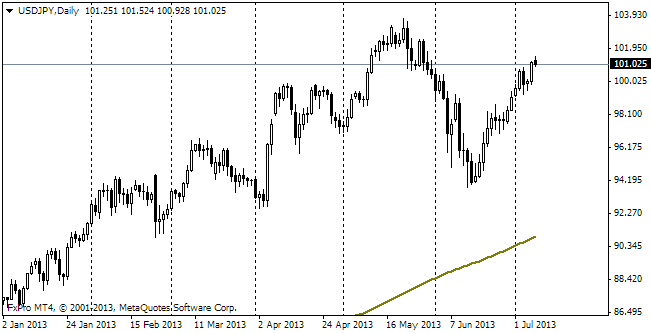EUR/usd
Yesterday we again saw how the market was ‘selling' facts. The so-much-awaited report on consumer prices in the eurozone showed slowdown. The annual inflation is again at the lows of March (0.5%). Those, in their turn, are the lowest in five years. Before the release of the data the euro/dollar had been pushed down and the pair again had hit the local lows at 1.3585. However, the released statistics stirred short covering. It was supported afterwards. As a result, the euro grew to 1.3646. Since no input data have changed and the ECB is still expected to ease the policy, yesterday's movement is treated as nothing more than stop triggering and consolidation before the important part of the week. Today and in the coming few days we will get ADP's employment statistics. It is expected that employment would grow by approximately 215K, which is a bit less than a month ago, but still a considerable increase. If the actual rate proves to exceed these forecasts, we may see strengthening of the dollar. The markets will stake that those like Fisher will be many in the fomc soon. At night he stated that he would prefer to end QE in October. Yet, even this ultra-hawk said that he didn't expect increase in the rates this year. Tomorrow is expected to abound in market movements. In the recent months draghi's comments at monthly press-conferences have often caused deceptive movements. Probably, the stream of important news later this week will manage to wake the market from the state of lowered volatility. And now not only market commentators, but even the Fed's officials are worried about it. That same Fisher spoke about it yesterday and Dudley also did last month.
GBP/USD
Yesterday proved to be less fortunate for the sterling than for the euro. The British pound was gradually sold during the day after the initial growth impulse. The statistics from the real estate sector still point at its heat, though it is clear that it can't get hotter. The Construction PMI shrank from 60.8 to 60 in May and this is already the fourth month of decline. The housing prices keep growing, but Nationwide sees signs of decrease in the consumer demand. Quite possibly, the pound has put an end to the consolidation. The situation can be aggravated by slowdown in the securities market.

USD/CAD
Today the BOC has another meeting to discuss the rate. It is unlikely to bring anything more than standard comments. In the meantime, we should be ready if the rhetoric is more optimistic than in the preceding months. Inflation is gaining momentum and in April made 2.0%. The annual rate of economic growth totals the solid 2.1% despite the slowdown from 2.3% a quarter before. The only obstacle to normalization of the policy is foreign and trade deficit. This quite an unusual state for the Canadian economy has been caused by increase in the domestic energy production in the USA.

USD/JPY
The yen is waking up. Since the beginning of the month it has been depreciating against most active currencies, to say nothing about the vigorous dollar. Now usdjpy is at the monthly highs at 102.70. Yet, at the moment it is too early to speak about the end of sideways trading for the pair. The yen is in demand on going below 103.
